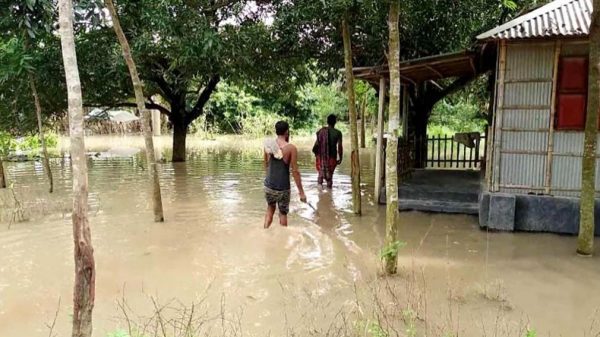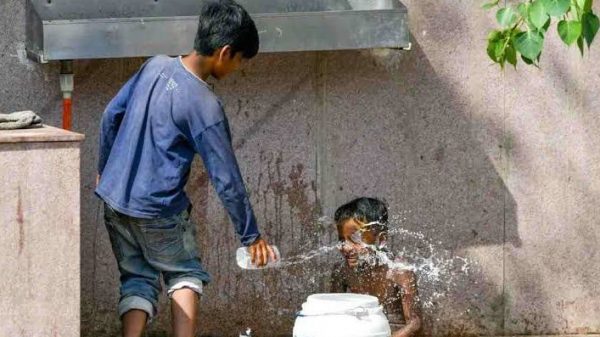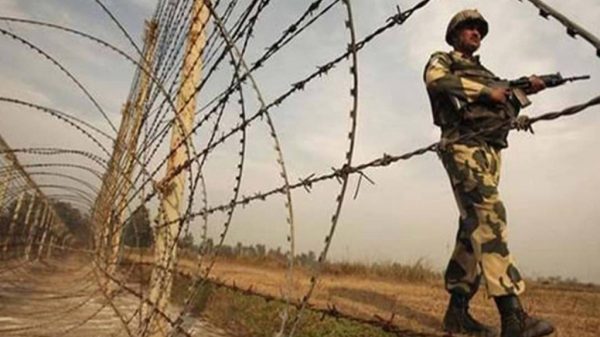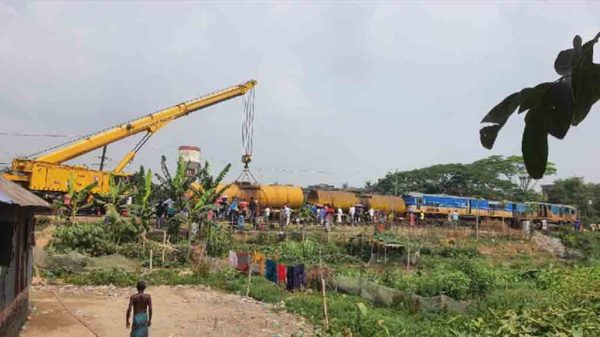Flood woes intensify as Ganges flow keeps rising

Shawdesh Desk:
Water in the river Padma and its tributaries on Wednesday continued to swell as upstream flow from India continued feeding the rivers in Bangladesh after India opened all the floodgates at Farakka Barrage on the Ganges on Sunday.
Flood situation worsened in Kushtia and Pabna while many areas of Chapainawabganj, Rajshahi, Sirajganj, Tangail, Munshiganj, Manikganj, Magura, Faridpur, Madaripur and Shariatpur are feared to go under water.
All the major rivers in Bangladesh are in rising trend except the Jamuna. The River Padma and its tributaries and the Meghna are in rising trend which may continue in the next two days, warned the Flood Forecasting and Warning Centre.
Though rainfall decreased in Bangladesh on Wednesday, due to increased flow of upstream water from India, the River Padma and its tributaries continued to swell, according to the Bangladesh Met Office and FFWC.
FFWC said, the Padma and Gorai rivers would likely to contribute to the worsening of the flood situation in the low-lying areas of Pabna, Kushtia, Magura, Rajbari, Manikgonj, Faridpur, Madaripur, Shariatpur and Munshiganj.
Bangladesh is on the floodplains of the Himalayan rivers.
Floods, once the lifeline of Bangladesh, became a source of woes due to inept water diplomacy with neighbouring India.
Barrages built by India at the upstream are used to hold back water during the dry season but the floodgates are opened in the monsoon which inundate the lower riparian Bangladesh.
In the last flood spanning July to August, at least 108 people died due to flood, according the Health Emergency Operation Centre and Control Room of Bangladesh.
FFWC said Wednesday afternoon that Padma was flowing 13 cm above danger level at Goalanda point and 8 cm above danger level at Hardinge Bridge point.
Padma’s tributary Gorai is flowing above 23 cm of danger level at Kamarkhali point while another Padma’s tributary Pashur at Khulna point was flowing above 35 cm of danger level. Meghna was flowing above 12 cm of danger level at Meghna Bridge point.
Heavy rains caused severe flooding in India’s Bihar and Uttar Pradesh in the fourth week of September killing more than a hundred people.
India reportedly opened all the 109 floodgates at Farakka Barrage on Sunday, releasing 55,000 cubic meter of water toward Bangladesh every second to lessen water pressure on the barrage.
Indian Met Office predicted that rain would lessen in the coming days.
Bangladesh Met Office said at 6pm Wednesday that in past 24 hours, major rainfall were recorded at 85 mm in Khepupara of Barishal, 88 mm in Khulna, 22 mm at Kumarkhali in Kushtia, 30 mm at Tarash in Rajshahi and 36 mm in Sylhet.
Met Office said in next 24 hours from 6:00pm Wednesday, light to moderate rain or thunder showers accompanied by temporary gusty wind is likely to occur at many places over Khulna, Barishal, Chattogram and Sylhet divisions and at a few places over Rangpur, Rajshahi, Mymensingh and Dhaka divisions with moderately heavy to heavy rainfalls at places over Khulna, Barishal Chattogram and Sylhet divisions.
Met Office said the axis of monsoon runs through India’s Uttar Pradesh, Madhya Pradesh, Bihar, West Bengal and Assam and across central part of Bangladesh.
New Age correspondent in Kushtia reported that the flood situation in Kumarkhali and Daulatpur in the district worsens on Wednesday as Padma continued overflowing.
About 5 meters of Kuthi Bari Barrage collapsed due to the rise and intense flow of water.
Several villages were marooned due the flooding.
Around 50,000 people of four unions under Daulatpur upazila have been inundated.
Villagers on the river bank are taking shelter at the flood control embankment and other dry places and some took shelter at their relatives’ homes.
Shilaidah Union Parishad chairman Salauddin Khan told New Age that the situation would worsen if the water continued to swell.
New Age correspondent in Pabna reported that rise of water massively damaged the winter crop cultivation in six out of nine upazilas in Pabna.
The water from Padma affected Pabna Sadar, Ishwardi and Sujanagar upazila in the last two days.
The rise of water level may continue for the next two or three days, said Mosharaf Hossain, assistant director of Pabna water development board.
Azahar Ali, deputy director of Pabna Agriculture Extension Department, said the floodwater massively damaged the winter crop in the last couple of days.
Around 12,500 hectors of land was inundated, causing serious damage to winter vegetables and lentils.
Six thousand farmers in six upazilas of the district incurred huge losses, Azhar said.
If the water level continued to increase more areas would be affected, damaging massive portion of the winter crops in the district, he said.
In Chapainawabganj, at least 10,000 people were stranded in parts of the Sadar and Shibganj upazilas on Wednesday as the water level of the Padma and Mahananda rivers increased further, reported UNB.
Low-lying areas, including crop fields, and a number of houses have been flooded, locals said.






















Leave a Reply